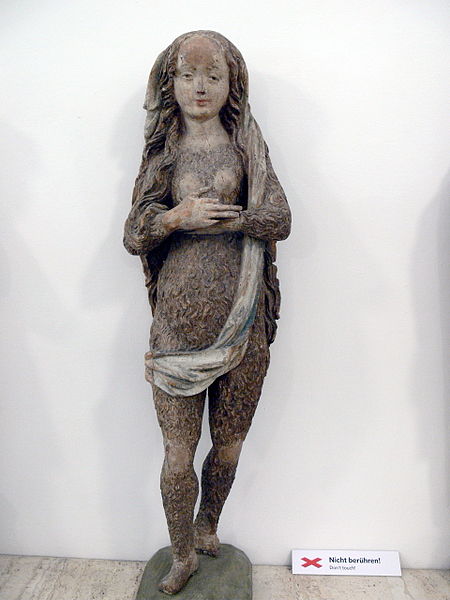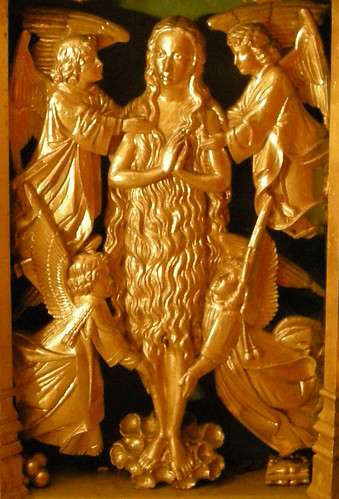Mary Magdalene: Patron Saint of Perfume (edit)

I find it very interesting that Mary Magdalene is the patron saint of perfume. Her legend is so multifaceted, so sensory, and so deeply complex that I have to concede that she makes a perfect object of contemplation for the perfumer (and the lover of perfume, of course!). Her status (erroneously attributed to her in the sixth century by the ubiquitous Legenda Aurea or The Golden Legend in English) as a reformed prostitute landed her squarely in the world of the sensual, and her ritualistic, emotive actions subsequent to her conversion only enhanced this reputation. For example, Mary Magdalene was believed to have washed Jesus’ feet with her penitent tears and a whole box of spikenard; perfuming them, if you will, with the liquid of new-found holiness. The passage is so super-sensual I’ll include it here:
and anointed the feet of Jesus, and wiped his feet with her hair;
and the house was filled with the odour of the ointment.' (John - Chapter 12: 3)
Although spikenard is not a common ingredient in modern perfumery, we can imagine the gorgeous scent of this earthy balm—spikenard smells a bit like valerian, a bit like vetiver--pouring out over the doomed man’s feet, and the luxurious spectacle of this woman wiping down the leader’s feet with her hair (generally depicted as red, the color of passion, or later blonde, the color of elite beauty in the Middle Ages and Renaissance) in a posture both of deep abjection and of great intimacy. It is that sensual intimacy, the sense of luxuriousness, as well as, arguably, the abjection of covering one’s imperfect human body with exotic unguents from animals and plants that gives the art of perfumery its great mystery, and it is all captured here in this one moment of pathos.
But Mary Magdalene is also associated with that most sensual of bodily adornments, hair, in other strange ways, and her hair also seems always to be connected somehow with the ideas of fragrance and death—it is important to note that M M is also the patron saint of hairdressers (LOL). After her conversion, whe she was reputed to have retreated from the world in penance, some legends describe her as a wild hermit whose bestial nature fundamentally marked her body; she grew a silken hair all over her body! This is a conflation of the idea of Mary Magdalene as a penitent sinner and hermit—and legends of hairy anchorites-- with the idea of wild sexuality, as embodied by Orientalist legends of wild women in the east whose ravenous sexuality manifests itself on their bodies, making them look more animal than human.
M is also the patron saint of hairdressers (LOL). After her conversion, whe she was reputed to have retreated from the world in penance, some legends describe her as a wild hermit whose bestial nature fundamentally marked her body; she grew a silken hair all over her body! This is a conflation of the idea of Mary Magdalene as a penitent sinner and hermit—and legends of hairy anchorites-- with the idea of wild sexuality, as embodied by Orientalist legends of wild women in the east whose ravenous sexuality manifests itself on their bodies, making them look more animal than human.
 M is also the patron saint of hairdressers (LOL). After her conversion, whe she was reputed to have retreated from the world in penance, some legends describe her as a wild hermit whose bestial nature fundamentally marked her body; she grew a silken hair all over her body! This is a conflation of the idea of Mary Magdalene as a penitent sinner and hermit—and legends of hairy anchorites-- with the idea of wild sexuality, as embodied by Orientalist legends of wild women in the east whose ravenous sexuality manifests itself on their bodies, making them look more animal than human.
M is also the patron saint of hairdressers (LOL). After her conversion, whe she was reputed to have retreated from the world in penance, some legends describe her as a wild hermit whose bestial nature fundamentally marked her body; she grew a silken hair all over her body! This is a conflation of the idea of Mary Magdalene as a penitent sinner and hermit—and legends of hairy anchorites-- with the idea of wild sexuality, as embodied by Orientalist legends of wild women in the east whose ravenous sexuality manifests itself on their bodies, making them look more animal than human.Her final link with perfume comes the day after the death of Jesus, since she is one of the myrrhbearers who come to the tomb to scent and embalm the body of the crucified leader, and, according to the story, find him gone! Here, the sensual aspects of frag rance intersect with the more morbid aspects of perfumery, since Mary Magdalene and her companions intend to perfume the body of a dead man. Perfume has been used to embalm corpses since literally the beginning of recorded history, and the legend of the patron saint of perfumery forces us to remember this fact. Interestingly, some of the most heady classic ingredients of perfume contain indoles, and share many qualities in common with rotting flesh—that super sweet smell that is both heady and overwhelming.
rance intersect with the more morbid aspects of perfumery, since Mary Magdalene and her companions intend to perfume the body of a dead man. Perfume has been used to embalm corpses since literally the beginning of recorded history, and the legend of the patron saint of perfumery forces us to remember this fact. Interestingly, some of the most heady classic ingredients of perfume contain indoles, and share many qualities in common with rotting flesh—that super sweet smell that is both heady and overwhelming.
 rance intersect with the more morbid aspects of perfumery, since Mary Magdalene and her companions intend to perfume the body of a dead man. Perfume has been used to embalm corpses since literally the beginning of recorded history, and the legend of the patron saint of perfumery forces us to remember this fact. Interestingly, some of the most heady classic ingredients of perfume contain indoles, and share many qualities in common with rotting flesh—that super sweet smell that is both heady and overwhelming.
rance intersect with the more morbid aspects of perfumery, since Mary Magdalene and her companions intend to perfume the body of a dead man. Perfume has been used to embalm corpses since literally the beginning of recorded history, and the legend of the patron saint of perfumery forces us to remember this fact. Interestingly, some of the most heady classic ingredients of perfume contain indoles, and share many qualities in common with rotting flesh—that super sweet smell that is both heady and overwhelming.If you think about it—you don’t have to—the topnotes of perfumery combined with the woody, balsamic heart and basenotes, emulate the smell of an embalmed body, with the topnotes, citrusy and indolic, reproducing the faint odor of corruption, while the basenotes replicate
the balms and unguents used in classic

enbalming. I know it’s gross to think about
this, but there it is.
A link to Professor Witcombe’s interesting page on the cult of Mary Magdalene
German Legends of the Hairy Anchorite / Studies in the Platonic Epistl






I enjoyed your blog entry here... to quote myself, (we) "Perfumers are missionaries of the Beautiful."
ReplyDeletefjtcn78m69
ReplyDeletegolden goose outlet
supreme outlet
golden goose outlet
golden goose outlet
golden goose outlet
golden goose outlet
golden goose outlet
golden goose outlet
golden goose outlet
golden goose outlet